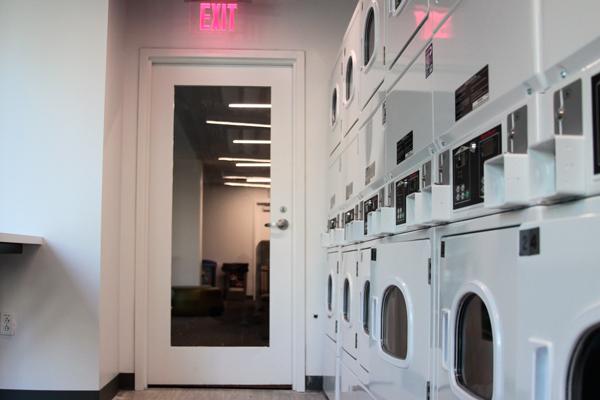District House is the latest addition to a long list of eco-friendly buildings on campus.
Five sustainability features were added to District House to help the building achieve a sustainable certification from the U.S. Green Building Council. Experts say that the low-flow plumbing fixtures, energy saving thermostats, green roof, secure bike storage and centrally powered bathroom fans will save money in the long run by reducing energy costs and contribute to healthier lifestyles for residents.
University spokesman Brett Zongker said in an email that GW is the first D.C. campus to commit to a minimum LEED standard on all new construction projects. The features in District House demonstrate a wider campus commitment to sustainable building, he said.
“Some sustainable features such as low-flow plumbing fixtures and energy saving thermostats are part of GW’s facilities standards being implemented as facilities are updated and fixtures replaced,” Zongker said. “Since the implementation of low-flow plumbing fixtures in other projects, GW has reduced water usage by more than 30 percent.”
Zongker declined to give the prices of each feature.
Karl Pederson, the vice president of District House’s Residence Hall Council, said that a “green” building will help teach residents about sustainability. The Council will hold a town hall this week to talk to students about the features and receive general feedback on the building.
“I think it’s really cool that GW is trying to protect the environment when many different colleges and universities around the country either haven’t taken that step or are hesitant to take that step,” Pederson said.
The LEED certification, or Leadership in Energy and Environmental Design, is a building program directed by the U.S. Green Building Council, a non-profit organization that promotes sustainability.
LEED certification requires buildings to accumulate points in nine different categories of energy conservation, such as water efficiency and indoor environmental quality. Depending on how many points a building earns, it can reach a silver, gold or platinum certification level.
GW has two silver certified buildings and nine gold certified buildings. The Milken Institute School of Public Health is GW’s only platinum-certified building.
“This process is entirely voluntary,” Jay Wilson, a green building program analyst at the Department of Energy and Environment, said. “New buildings and substantially renovated buildings have to meet our green building codes, and LEED is an option under the green building code.”
The average cost to complete a LEED certification process for a building less than 50,000 square feet can be more than $3,000, according to the U.S. Green Building Council’s website.
Each green feature in District House fits into a different LEED category. For example, secure bike storage, which encourages students to travel on bike rather than use energy by taking public transportation, satisfies the “location and transportation” category.
A 12,500-square-foot green roof scores District House points in the “sustainable sites” category. Water-absorbing plants on the rooftop will both decrease river pollution from stormwater runoff and reduce the “urban heat island” effect.
A central rooftop fan powers automatic bathroom fans in every room, which satisfies the LEED indoor air quality category by ventilating the rooms and regulating indoor temperatures.
JR Fulton, the capital planning and sustainability manager with housing and food services at the University of Washington, said that this feature primarily addresses health concerns because it improves air quality.
“You’re able to have more fresh air, more outside air and less smelly air, too,” Fulton said.
A low-flow plumbing system reduces the amount of water used to run dishwashers and laundry machines, which has the potential to reduce water usage by 44 percent, according to an email sent to District House residents obtained by The Hatchet.
District House also has thermostats that reduce energy in heating and cooling the building.
Still, some residents of District House told the Hatchet that the green features have made their first weeks in the new residence hall less than ideal, citing issues with controlling the temperature in their rooms, low water pressure and noise from continued construction on the roof and basement.
“We continue to work with building residents and staff to ensure these features function as intended and encourage any residents with questions or concerns about these features to file a FixIt ticket so we can confirm if there are any other issues that may be affecting these features,” Zongker said.







